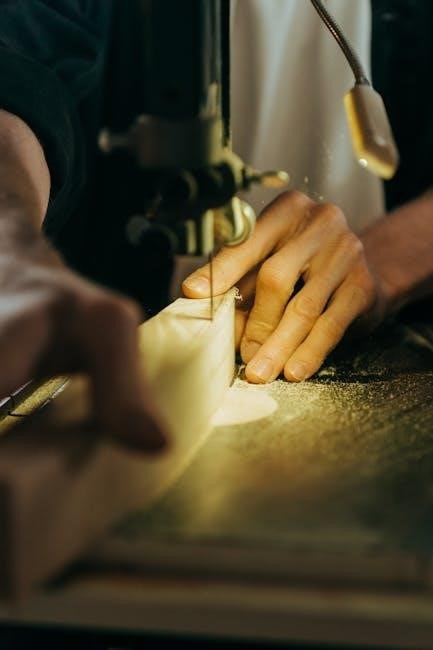A comprehensive guide to construction techniques offers practical insights into modern building methods, materials, and tools․ It emphasizes safety, efficiency, and sustainability, providing a foundation for successful projects․
1;1 Overview of Modern Construction Practices
Modern construction practices emphasize efficiency, sustainability, and safety․ Techniques include the use of advanced materials like reinforced concrete and engineered wood, alongside sustainable building methods․ These practices aim to minimize environmental impact while ensuring durability and cost-effectiveness․ The integration of technology, such as BIM (Building Information Modeling), has revolutionized project planning and execution․ Adherence to updated building codes ensures structural integrity and safety standards are met, guiding the industry toward innovative and reliable solutions․
1․2 Importance of Safety and Efficiency in Building
Safety and efficiency are critical in construction, ensuring projects are completed on time and without risks․ Proper safety protocols prevent accidents, while efficient practices optimize resource use․ Adhering to safety standards protects workers and structures, while efficient techniques enhance productivity․ Combining these elements ensures long-term durability and reduces costs, making them essential for successful building projects․ Both aspects are non-negotiable in modern construction, driving the industry toward better outcomes and compliance with regulations․

Foundation Work
Foundation work is essential for ensuring stability and durability in construction․ It involves selecting the right materials and techniques to support the structure’s loads effectively․
2․1 Choosing the Right Foundation Type
Selecting the appropriate foundation type is crucial for a structure’s longevity․ Factors such as soil conditions, load-bearing capacity, and environmental factors guide the decision․ Shallow foundations, like spread footings, are suitable for stable ground, while deep foundations, including piles or caissons, are used for unstable or soft soil․ The choice also depends on the building’s weight and local construction codes to ensure stability and safety․
2․2 Materials and Methods for Foundation Laying
Concrete, reinforced concrete, and steel are commonly used materials for foundation laying․ Techniques like spread footings and piles are employed based on soil conditions․ Proper compaction and leveling ensure a stable base; Advanced methods include precast concrete and specialized equipment for deep foundations․ Adhering to construction codes and precise execution are essential for long-term reliability and safety․

Wall Construction
Wall construction involves using materials like bricks, concrete blocks, and wood․ Techniques ensure structural integrity, insulation, and aesthetics, forming a durable and functional building envelope․
3․1 Types of Walls: Load-Bearing and Non-Load-Bearing
Load-bearing walls support structural weight and transfer it to the foundation, ensuring stability․ Non-load-bearing walls partition spaces without carrying structural loads․ Both require precise construction techniques for durability and safety․
3․2 Materials for Wall Building: Bricks, Concrete Blocks, and Wood
Bricks offer durability and aesthetic appeal, while concrete blocks provide strength and thermal mass․ Wood is lightweight and easy to work with, ideal for framing․ Each material has unique benefits and applications in wall construction․
3․3 Structural Reinforcement Techniques
Structural reinforcement techniques enhance wall stability, ensuring durability and safety․ Steel rebar is often embedded in concrete to withstand tension and compression․ Reinforced concrete chaining strengthens walls, transferring vertical and horizontal loads to foundations․ These methods ensure structural integrity, especially in load-bearing walls, while maintaining design flexibility and resilience against environmental stresses․
Roof Construction
Rooftop construction involves selecting durable materials like tiles, metal, or slate․ Proper framing techniques ensure structural integrity and weather resistance, enhancing overall building stability and longevity․
4․1 Types of Roofing Materials: Tiles, Metal, and Slate
Roofing materials like tiles, metal, and slate offer durability and aesthetic appeal․ Tiles provide excellent weather resistance, while metal roofs are lightweight and long-lasting․ Slate, known for its strength and sustainability, is a premium choice․ Each material caters to different architectural styles and environmental conditions, ensuring versatility in construction projects․ Proper selection enhances structural integrity and longevity, making these materials popular in modern and traditional builds․
4․2 Framing Techniques for Durable Roof Structures
Framing techniques are crucial for creating strong and durable roof structures․ Common methods include traditional rafter systems, prefabricated trusses, and beam construction․ Precision in measuring and cutting ensures stability, while proper fastening enhances safety․ Regular inspections and adherence to building codes are essential for long-term durability․ Modern techniques also incorporate energy-efficient designs, optimizing structural integrity and weather resistance for reliable performance in various environmental conditions․
Insulation and Energy Efficiency
Insulation is vital for reducing heat loss and improving energy efficiency in buildings․ Proper materials and techniques minimize thermal transfer, lowering energy costs and environmental impact effectively․
5․1 Importance of Thermal Insulation in Buildings
Thermal insulation is crucial for maintaining consistent indoor temperatures, reducing energy consumption, and lowering heating and cooling costs․ It prevents heat loss in winter and heat gain in summer, ensuring comfort while minimizing environmental impact․ Proper insulation also protects buildings from moisture damage and condensation, extending their lifespan․ Additionally, it contributes to soundproofing, enhancing overall living and working conditions significantly․
5․2 Materials and Methods for Effective Insulation
Common insulation materials include fiberglass, cellulose, and foam board, each offering varying levels of thermal resistance․ Proper installation is key, with techniques like sealing air leaks and installing vapor barriers․ Advanced methods include spray foam insulation for tight spaces and radiant barriers for reflecting heat․ These materials and techniques ensure energy efficiency, reduce moisture issues, and create a comfortable indoor environment while adhering to building codes and sustainability standards․

Doors and Windows
Doors and windows are essential for functionality and aesthetics, offering natural light and ventilation․ Proper selection ensures energy efficiency, security, and durability, enhancing overall building performance․
6․1 Selection Criteria for Doors and Windows
When selecting doors and windows, consider material durability, energy efficiency, and aesthetic appeal․ Factors like thermal insulation, soundproofing, and maintenance requirements are crucial․ Wood, metal, and PVC are common materials, each offering unique benefits․ Energy-efficient options, such as double-glazed windows, reduce heat loss and energy costs․ Additionally, consider security features and ease of operation․ The choice should align with the building’s design and budget, ensuring functionality and long-term performance․
6․2 Installation Techniques for Optimal Functionality
Proper installation of doors and windows ensures long-term functionality and energy efficiency․ Use precise measurements and alignment tools like levels and drills for accurate fitting․ Seal gaps with weatherproof materials to prevent air leaks and moisture damage․ Ensure frames are securely fastened to walls for stability․ Regular maintenance, such as lubricating hinges and checking seals, is essential for optimal performance․ Proper installation enhances durability, security, and energy savings, making it a critical step in construction․

Flooring Options
Flooring options vary widely, offering choices like hardwood, tile, carpet, and laminate․ Each material provides unique benefits, from durability to aesthetics, tailored to specific needs and budgets․
7․1 Practical and Technical Considerations for Flooring
When selecting flooring, consider factors like durability, maintenance, and compatibility with the building’s structure․ Moisture levels, traffic patterns, and acoustic requirements also play a role․ Materials must align with the intended use of the space, ensuring both functionality and aesthetics․ Proper subfloor preparation is crucial for a stable and long-lasting installation․ Additionally, environmental and budget constraints should guide decisions to ensure a practical and technically sound choice․
7․2 Installation Methods for Different Floor Types
Different flooring types require specific installation techniques․ For tile flooring, a level subfloor and adhesive are essential, followed by grouting․ Wood flooring involves nailing or gluing planks to a prepared subfloor․ Concrete floors are poured and finished with specialized tools․ Each method ensures durability and aesthetic appeal, tailored to the material and intended use․ Proper installation guarantees a stable, functional, and visually appealing floor, meeting both practical and technical standards․
Interior and Exterior Finishing
Interior and exterior finishing involves techniques like painting, surface treatment, and installing trim․ These processes enhance aesthetics and protect structures from environmental factors, ensuring durability and appeal․
8․1 Finishing Techniques for Walls and Ceilings
Finishing techniques for walls and ceilings involve smoothing surfaces, applying plaster or drywall, and painting․ These methods ensure a polished appearance and durability․ Proper surface preparation is key․
Materials like plaster, paint, and trim are commonly used․ Attention to detail ensures seamless joints and a professional look․ These techniques also enhance acoustic and thermal performance, creating a comfortable living space․
8․2 Painting and Surface Treatment Methods
Painting and surface treatment methods enhance aesthetics and protect surfaces․ Techniques include primer application, paint selection (latex, epoxy), and tools (rollers, sprays)․ Surface preparation is crucial for durability․
Methods like sanding ensure smooth finishes, while materials like wood or metal require specific treatments․ Proper application ensures long-lasting results and resistance to environmental factors․ These steps are vital for maintaining the integrity and appearance of interior and exterior surfaces․
Plumbing and Sanitary Systems
Plumbing and sanitary systems involve installing water supply and drainage networks․ Proper installation ensures safe water distribution, waste removal, and system longevity, adhering to safety standards․
9․1 Installation of Water Supply and Drainage Systems
Installing water supply and drainage systems requires precise planning and execution․ Materials like PVC, copper, and PEX pipes are commonly used for durability and reliability․ Proper sizing and routing ensure efficient water distribution and waste removal․ Safety standards must be adhered to, including pressure testing and leak prevention․ Regular maintenance is essential to prevent blockages and corrosion, ensuring long-term functionality and hygiene in residential and commercial buildings․
9․2 Safety and Maintenance Tips for Plumbing
Regular inspections and maintenance are crucial for plumbing systems to ensure longevity and functionality․ Inspect pipes for leaks, corrosion, or damage, and address issues promptly․ Use high-quality, durable materials like PEX or copper to minimize risks․ Follow safety standards, such as proper ventilation and pressure testing, to prevent hazards․ Keep drainage systems clear of debris and consider installing water filters for improved water quality․ Annual professional checks can prevent major plumbing failures and ensure compliance with local codes․
Electrical Systems
Electrical systems involve proper design, installation, and maintenance to ensure safety and efficiency․ Compliance with local codes and standards is essential for all projects․
10․1 Wiring and Circuit Installation
Proper wiring and circuit installation are crucial for electrical systems․ Techniques include planning layouts, selecting appropriate materials, and ensuring all components meet safety standards․ Professional installation prevents hazards and ensures efficiency․
10․2 Safety Considerations for Electrical Work
Safety is paramount in electrical work․ Always adhere to local codes and regulations․ Use personal protective equipment and ensure circuits are de-energized before starting work․ Proper tool selection and regular inspections prevent accidents․ Training and certification are essential for handling electrical systems safely․ Grounding and bonding techniques must be implemented correctly to avoid shocks and fires, ensuring a secure environment for both workers and building occupants․
Effective construction techniques ensure durability, safety, and efficiency․ By following guides like “Guide Technique et Pratique de la Construction,” builders can achieve successful, high-quality projects consistently․
11․1 Summary of Key Construction Techniques
The guide provides a detailed overview of modern construction methods, emphasizing safety, efficiency, and sustainability․ Key techniques include proper site preparation, foundation laying, structural framing, and roofing․ Insulation, finishing, and installation of plumbing and electrical systems are also covered․ These methods ensure durability and compliance with building codes, offering practical solutions for both residential and commercial projects․
11․2 Final Tips for Successful Building Projects
For a successful project, prioritize thorough planning, skilled labor, and quality materials․ Ensure compliance with safety standards and building codes․ Regular inspections and maintenance are crucial for longevity․ Adopt sustainable practices to reduce environmental impact․ Stay updated on the latest construction trends and technologies․ A well-executed plan, combined with attention to detail, ensures durability and functionality, making your project a lasting success․


